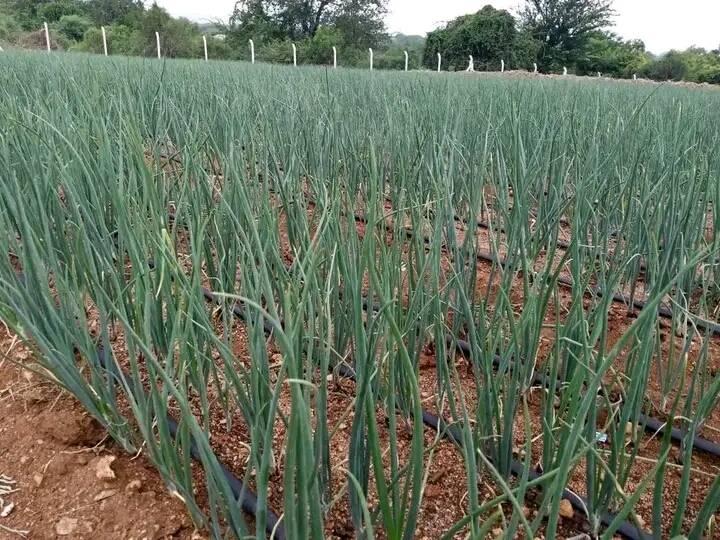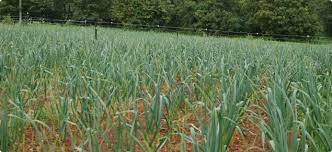Garlic Irrigation Farming in Kenya

Garlic irrigation farming in Kenya works with drip irrigation method, which delivers water directly to the plant root zones.
Aqua Hub Kenya guides you on the steps on how garlic irrigation farming is done and proceeds to supply garlic irrigation drip kits. We also install irrigation accessories at affordable prices in Kenya.
How much are garlic Drip Kits in Kenya?
Our garlic irrigation farming kits consist of the normal drip kit accessories and cost different for every farm size. Price also depends on the number of lines on each planting bed.
For instance, price for 1, 2, and 3 beds are ;
| Size / Lines Per Bed | 1 Line | 2 Lines | 3 Lines |
| 1 Acre | 75,000 | 130,000 | 160,000 |
| 1/2 Acre | 40,000 | 61,000 | 71,000 |
| 1/4 Acre | 28,000 | 40,000 | 50,000 |
| 1/8 Acre | 13,000 | 23,000 | 26,000 |
Varieties for Garlic in Kenya
Hard neck garlic:
- Develops bulbs with fewer and larger cloves
- Strong and pleasant flavour
Soft neck garlic:
- Produces smaller, more tightly packed cloves
- Unlikely to bolt, except in poor growing conditions
Conditions for Garlic Irrigation Farming in Kenya
- Garlic does well at an altitude of between 500-2000, m above sea level.
- Low temperatures of between 12-24 °C.
- Extremely high temperatures are not suitable for garlic production.
Which soil is Ideal for Garlic Farming?
Garlic grows better in highly fertile and well-drained light loam soils. It is not suitable for regions with clay or highly compacted soils.
What is the ideal Soil PH Requirement?
The recommended soil PH is within a range of 5.5 to 6.8.
Water Requirement in Garlic Irrigation Farming in Kenya
Garlic requires small amounts of water, but it can vary with the growing stage. Much water is needed at the early planting stages.
In areas with unsustainable rainfall levels, irrigation is necessary to maintain the water requirement.
The soil needs to be watered to a level of 1 inch (2.54 cm) deep below the ground to enhance proper water availability and balance.
Requirements for Garlic Farming in Kenya
- Garlic Cloves – Garlic grows from cloves, a segment of the bulb.
- Lime – a substance added to the soil to lower the acidity of soil in areas below the recommended soil PH.
- Drip Irrigation Kit – Accessories for water supply in a drip irrigation model. Includes pipes, drip lines, and fittings.
- Fertilizer – 60-80 kg fertilizer during planting.
How profitable is Garlic irrigation farming in Kenya
Garlic farming is a highly profitable venture as it attracts a higher demand all throughout the year due to its use as a cooking spices. A kg of garlic can cost between KES 150 – KES 300 depending on the demand.
What is the Average Yield of Garlic Per Acre?
For most varieties of garlic, you will harvest 6-8 tonnes per acre.
What is the Cost of Starting Garlic Farming in Kenya?
The cost of starting garlic farming in Kenya includes drip irrigation kits, seedlings, land preparation, labour, installation and agronomy support.
It can cost KES 150,000 to KES 250,000 per acre depending on the irrigation layout and number of driplines per bed.
How to Identify the Best Garlic Cloves for Propagation
The ideal garlic cloves need to be firm and tightly clustered.
The cloves need to be left with their outer covers to protect it from decay.
Separate the cloves and leave them with their skins intact. The bigger the cloves are, the better the chances of growing high-quality garlic.
Garlic seedlings for sale in Kenya
Certified Garlic seedlings are available in popular seedling vendors such as Gracerock Farms. You can visit or Contact Gracerock farms to learn about the costs of garlic seeds and the quantity needed per acre.
Garlic Farming in Kajiado
The availability of cheap accessible land for lease makes it easier and convenient to grow garlic in Kajiado. The warm climatic condition enhances growth and maturity of garlic.
Garlic Irrigation Farming in Machakos
You can also get access to drip kits for starting garlic farming in Machakos county due to the hot climate and well drained soil.
Garlic can also be grown in Narok, Nakuru, Kirinyaga, Embu, Kiambu, Kirinyaga, Murang’a and Laikipia.
How to grow Garlic
Before any attempt to venture into garlic farming, it is essential to learn the steps to take and the requirements to ensure success.

Steps for Garlic Irrigation Farming in Kenya
Land Preparation
The first step taken in garlic farming entails clearing and digging the land to make it suitable for garlic planting. Other obstacles, such as rocks, and tree roots, should be removed from the farm to clear room for growing garlic.
After proper land cultivation, 1 inch (2.54 cm) below the soil, mix the soil with manure.
Bed Preparation
Garlic is grown in raised beds of about 3 M wide and 100 m Long. The beds take a height of approximately 30 cm.
The spacing between the garlic beds usually takes 1 M for movement and flood control.
Planting Garlic Cloves
Before you start planting, you must acquire garlic cloves, you can buy it from quality seed vendors. If the cloves are not dry and ready for propagation, store them in a cool and dry place till they develop inner leaf sprouts.
Planting of garlic should be in an upright position, with the leaves protruding from the soil and soil covering up to the neck of the cloves.
Installation of Drip Irrigation Kits
After proper bed preparation, making trenches and planting, drip kits can then be installed. Installing after planting is good to prevent pipe damages that could occur in the process.
When and What Quantity of Fertilizer to Apply
Garlic is a heavy feeder, but the fertilizer recommendation should be guided by soil test results
During the planting time, the soil can be mixed with 80 Kg of TSP or manure per acre of land. Top-dressing after 4 weeks is ideal, with a CAN of 40 Kg per acre.
Weeding process
Normal weeding is essential to remove weeds and nutrient competing herbs and weeds.
Harvesting of mature Garlic
After around 4 to 5 months, the garlic plants should be ready for harvesting.
If the clove ridges are clearly defined and the bulbs are a decent size, and some leaves have died back, then harvest them. Avoid delays when harvesting as it may result in bulbs splitting, which may affect their quality.
You can manually harvest them by hand pulling or using a fork to dig them out.
Curing of Harvested Garlic
Curing makes garlic dry well and remain in good condition in the storage stage.
The curing process may take at least two weeks for garlic harvests to remain in proper storage condition.
For Assistance, Irrigation accessories and other Enquiries ;
Call 0790719020

